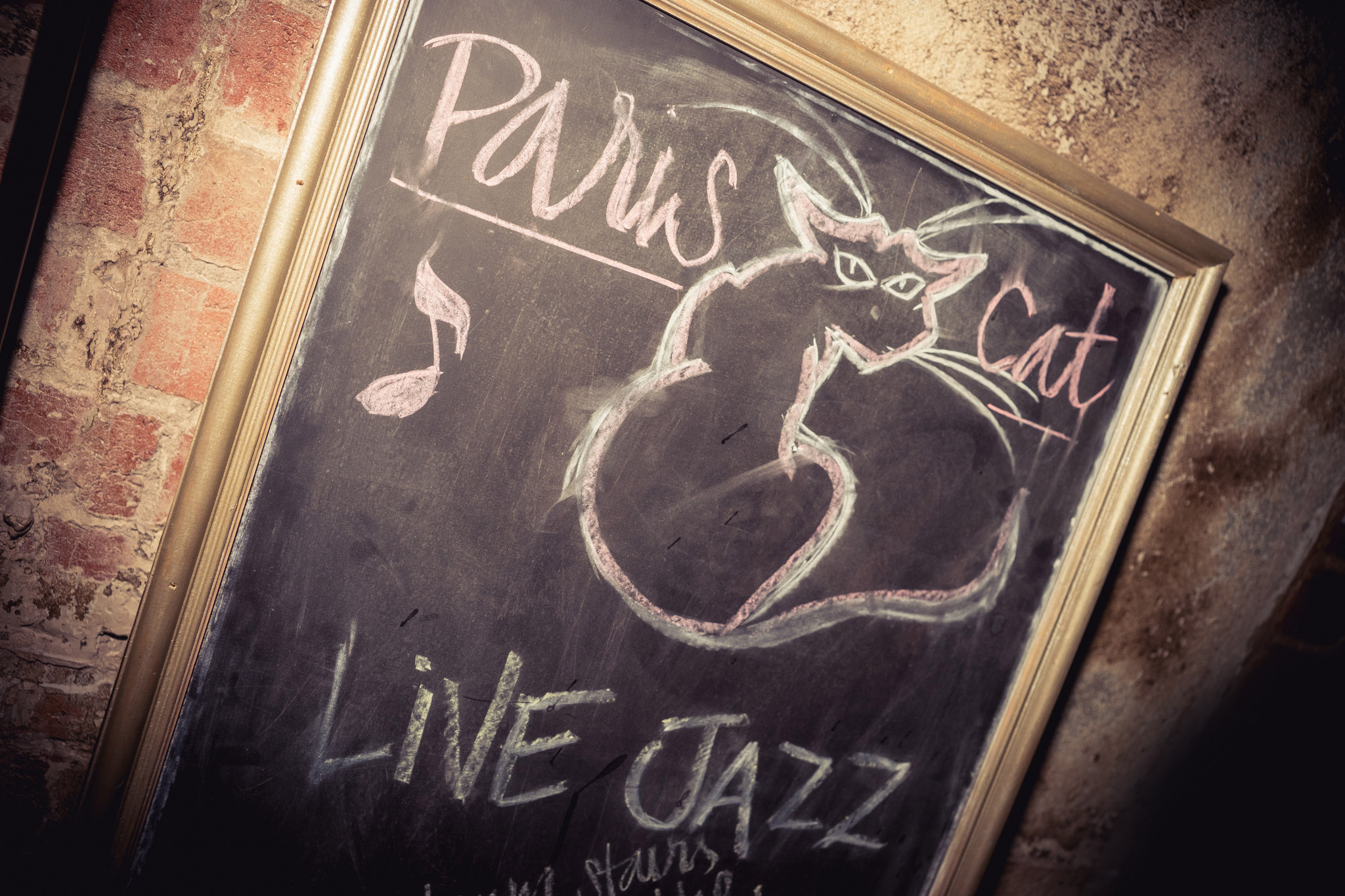Banking on jazz is a risky business. No one knows that better than Serge Carnovale, owner of Melbourne’s the Paris Cat jazz club. Tucked away in an inconspicuous city Melbourne laneway, the club has quietly grown to become that rarest of things: a profitable jazz venue.
When the Paris Cat opened in 2006, however, margins were nail-bitingly thin.
“Starting out, business was terrible,” says Carnovale. “Someone said to me that it’d take five years. They weren’t wrong.”

The Paris Cat’s Serge Carnovale. Picture: Zachary Snowdon Smith
For the first three years, Carnovale and others had to raise extra funds to keep the club from going under. On a Saturday night, the Paris Cat’s snug 80-seat basement rarely attracted more than 25 customers. In the era of streaming music, he found asking punters to pay at the door was a hurdle. Why shell out $7 to hear a local musician play My Funny Valentine when, on Spotify, you can listen to hear Chet Baker perform it for free?
Carnovale recalls an encounter he had shortly after the club opened:
“This gentleman came up and said to me, ‘I can’t believe you’d charge $7 to get into a bar,’ – a bar, he called it. I said, ‘Excuse me, sir, I’ve got an act from New York down there tonight..’ He said, ‘But none of the other bars around here charge’.’ I watched him walk away. He was a solicitor, who might have been on a couple of hundred thousand a year. It really flattened me. I thought, if someone who’s earning $200,000 a year doesn’t want to pay $7 to get in, what hope have we got?”
Before opening the Cat, Carnovale balanced an interest in music with the need to pay the bills, renovating houses during the day and playing drums on stage by night. Driving through the narrow, slightly crooked laneway Goldie Place in Melbourne’s CBD, he noticed a for-sale sign hanging in front of a narrow, red-brick property. Carnovale bought the property at auction and flew to Paris to gather inspiration from the city’s numerous small clubs de jazz, which have perfected the art of arranging a space that is cozy rather than cramped.
“What I was trying to bring back was the ambience of the era, an old-world style,” says Carnovale. “When we first started here, people were saying the building wasn’t big enough. I say it’s the perfect size.
“It’s special and intimate when you can be a metre from the stage. Sometimes it’s a lot more appealing than going to a concert venue with thousands of people and being 200 metres back.”
When the Paris Cat opened, it was heralded only by an illuminated sign reading ‘JAZZ’, so small it’s easy to miss until you’re standing right at the club’s door.
“I like to keep it a little bit inconspicuous,” says Carnovale. “One of the most pleasing comments I get is when a guest turns up and says, ‘It took me two hours to find this place.’ I love it when they do that, because you know they made every effort to be here.”
Since its precarious rocky beginnings, Carnovale has grown the club’s popularity by developing a database of thousands of performers and by staging tribute shows to iconic figures like John Coltrane, Thelonious Monk and Billie Holiday. By advertising familiar names and familiar tunes, Carnovale is able to draw in curious and casual listeners who might be scared off by the prospect of something more avant-garde. The club also dips into other genres, mingling classic styles like bebop and swing with soul, blues and funk to reach an audience beyond the hard core of jazz lovers.
Like chess, poetry and classical music, jazz can be seen as inaccessible and even intimidating, an impression sometimes encouraged by fans. Potential customers may hesitate to buy a ticket to a jazz show for fear of not “getting it.”. Tearing down that barrier has kept the Paris Cat purring along smoothly, with weekly attendance growing from around 200 people in 2006 to 600-plus people today, even as ticket prices have tripled.
“It wouldn’t matter if it were a jazz club or a cleaning business,: they take time to build,” says Carnovale. “There are going to be people that knock you along the way, but you’ve got to have faith. If you chop and change, you may as well not do it … We’ve decided to stick to developing Australian jazz. In doing that, we’ve created a loyal following, and it shows.”

Picture: Zachary Snowdon Smith
Despite its popularity, not everyone agrees that the Paris Cat has established its credentials in this rarified and passionately competitive space. Michael Tortoni owns and operates the Jazzlab, a Brunswick club where high-profile artists like Andrea Keller, Paul Grabowsky and Eugene Ball gather to experiment and try out new material.
“I don’t think you’re really getting to the heart of the jazz community at Paris Cat,” says Tortoni. “To me it’s more of a general music venue than a jazz club. It branches out into areas that aren’t necessarily jazz. I think it’s their way of surviving, trying to get numbers through the door.”
In 1992, Tortoni opened Bennetts Lane, a club that went on to feature virtually every significant Australian jazz artist practising at the time. Since closing its doors in 2015, Bennetts Lane has become the most mythologized venue in the Australian scene, and subsequent clubs have operated in its shadow. Tortoni opened the Jazzlab in 2017, and considers it the successor to Bennetts Lane.
The Jazzlab shares some similarities with the Paris Cat – its red-curtained performance room displays the same careful attention to ambience-building, and the bar, discreetly tucked off to the side, illustrates that this is a place where music comes before drinking and chatting.
But the clubs also represent opposing business models: while the Paris Cat depends on packing out its 80-seat basement and loft with multiple acts per night, the Jazzlab’s single 226-seat space is better suited to turn a profit on international acts.
In Tortoni’s eyes, the Jazzlab’s mission is not only to entertain audiences, but to propel the art form forward.
“With jazz, I think the ultimate aim is to develop a jazz audience, and I don’t think that enough attention is being paid to developing that audience,” says Tortoni.
“The culture of Bennetts Lane, which is now the Jazzlab, has always seen itself as an institution for creative development of the art form. That’s its mantra, and always has been.”

Photo: Zachary Snowdon Smith.
By delving so far into other genres, the Paris Cat has given up its chance to develop the jazz scene, says Tortoni argues.
But Carnovale is unmoved by these criticisms, and says that the Jazzlab will eventually be forced to offer more tribute shows and genre-bending entertainment in order to stay afloat.
“He can call his club a ‘real’ or ‘true’ jazz club, but, really, it’s only been in the scene for five minutes,” says Carnovale. “If you don’t have an audience, it doesn’t matter what you call yourself.”
Trumpet/flugelhorn player and vocalist Gianni Marinucci has played at both clubs, mounting and has mounted the stage at the Paris Cat over 300 times. At the Cat, his sensitive and melodious playing style and the understated blokiness of his stage persona have made him a reliable draw for audiences.
“I think the Paris Cat has had an amazing influence on the scene by giving lots of musicians a place to play,” says Marinucci. “Half these people will never play at the Jazzlab or Uptown Jazz Cafe – no way. They’re not considered ‘jazzy’ enough. ‘Cool’ enough. ‘Hip’ enough… Compared to other clubs, at the Paris Cat there’s less of a clique.”
A turning point in the Paris Cat’s development was in 2012 when Serge’s wife Liz took over as programming coordinator, Marinucci says. When someone says they’ve been in touch with the Paris Cat, they probably mean they’ve been in touch with Liz Carnovale.
Earlier in his career, Marinucci recalls being left hanging by other jazz clubs rather than being directly turned down. From his point of view, the best thing a club can do is give a musician a prompt “yes” or “no.”
“I try my best to respect that any email deserves a follow-up,” says Liz Carnovale. “It’s always a hard thing when you’re having to explain to a musician that guests aren’t responding to the material … They’re not the easiest of conversations, but I think it’s all in the delivery. You’ve got to take care.”
Marinucci fondly remembers the early days of Bennetts Lane, when musicians were free to blaze into strange new sonic territory onstage, although they might only go home with $10 in their pockets. But valuing that creativity doesn’t mean refusing to consider the bottom line, he says.
“Miles [Davis] was really interested in commerce,” says Marinucci. “He kept changing styles of music because he wanted people to buy his records. But now we have it that Miles changed styles all the time just because he was artistically driven to challenge himself. It wasn’t just that – he was into commerce. You have to figure out a way to make it work.”
Backwards-looking tribute shows deifying great musicians are in danger of pushing jazz into a swamp of nostalgia, he says. In Born to be Blue, his popular Chet Baker tribute show, Marinucci weaves original music in with the standards.
“You can write your own music – you just have to do it within the parameters,” says Marinucci. “You can be angry about tribute shows and tell yourself that they’re not real art and that only your music has a real, true voice. Or, you can say to yourself, I’m gonna put on this tribute show and, within that framework, get my own voice heard, connect with the audience and create a real, visceral experience that’s not rooted in nostalgia. That’s very challenging, but why shouldn’t a musician be challenged like everyone else?”
Regardless of philosophical differences, fans should be sure to check all of Melbourne’s jazz venues and help put a few more dollars in performers’ pockets, Marinucci says.
“Serge and Michael could make a lot more money by selling their buildings so they could be used for something else,” says Marinucci. “We’re all very fortunate that they’ve decided to run jazz clubs. They believe in it. So, hats off to all of them – Serge, Michael and Sonny [Rehe, of Uptown Jazz Cafe].”
When the Paris Cat reaches its 15th birthday, Carnovale is preparing to hand over the club to new operators so that he can spend more time with his children.
The Paris Cat’s legacy may come from the opportunities it’s given to young and emerging musicians, says Mal Stanley, presenter for ABC Radio National’s Jazztrack.
“Serge has done a pretty admirable job in establishing the club, making it financially viable,” says Stanley. “The Paris Cat’s an important part of the blend of Melbourne clubs. I think it’s a positive thing for the scene that all the clubs have their own identities and serve different audiences.”
Carnovale points out: “Although you may hear that jazz is dying, in Melbourne it’s not.”
This story is co-published with The Daily Review.




